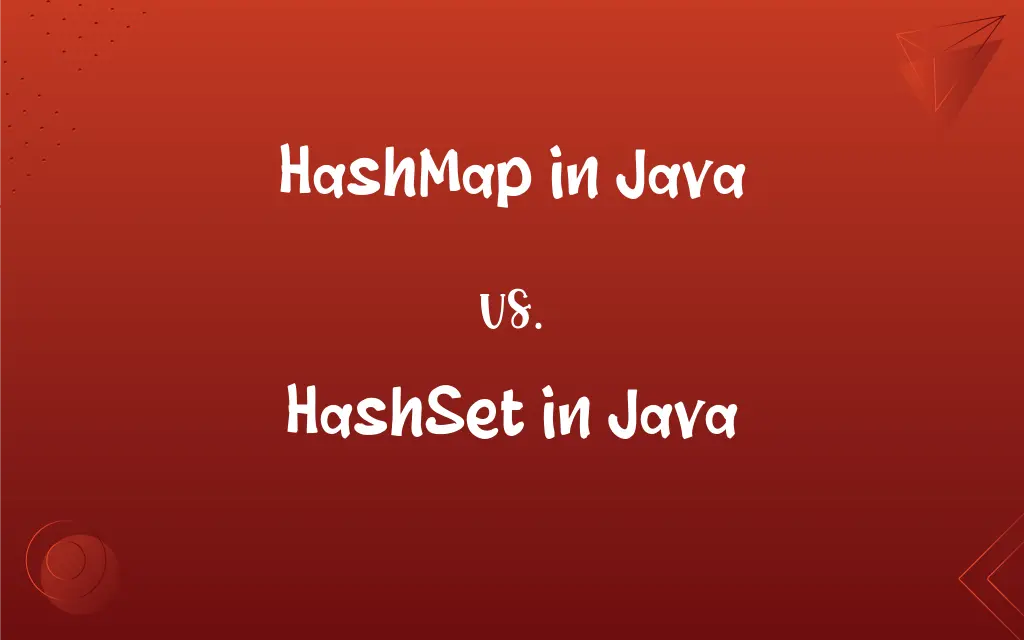HashMap in Java vs. HashSet in Java: What's the Difference?
Edited by Aimie Carlson || By Janet White || Published on February 21, 2024
In Java, a HashMap is a collection that stores key-value pairs, allowing duplicate values but not keys, while a HashSet is a collection that stores unique elements and doesn't maintain key-value pairs.

Key Differences
A HashMap in Java is a map-based collection used to store key-value pairs. Each key maps to a specific value. A HashSet, on the other hand, is a set-based collection used to store unique elements without any key-value mapping.
In a HashMap, keys are unique but values can be duplicated. In a HashSet, all elements are unique, and it does not support key-value pairs.
HashMaps are ideal for scenarios where you want to retrieve or update data based on key values. HashSets are used when the uniqueness of elements is the priority, without the need for mapping to values.
In a HashMap, operations like get and put are generally fast, depending on the hash function. In a HashSet, add, remove, and contains operations are efficient, as it uses a hash table for storage.
HashMap internally uses a hash table to store its key-value pairs. HashSet also uses a hash table but only stores keys without any corresponding values.
ADVERTISEMENT
Comparison Chart
Data Structure
Stores key-value pairs
Stores unique elements
Uniqueness
Keys must be unique, values can be duplicated
All elements must be unique
Typical Use
Retrieving/updating values based on keys
Checking presence of a unique element
Operation Speed
Fast access to elements via keys
Efficient add, remove, and contains operations
Internal Implementation
Uses a hash table for storing key-value pairs
Uses a hash table to store elements
ADVERTISEMENT
HashMap in Java and HashSet in Java Definitions
HashMap in Java
A collection in Java that maps keys to values, with unique keys and duplicate values allowed.
We used a HashMap in Java to store employee IDs and their names.
HashSet in Java
A collection in Java that stores unique elements only.
Our Java HashSet contains a list of unique customer IDs.
HashMap in Java
Does not guarantee the order of its elements.
The iteration order of our Java HashMap is unpredictable.
HashSet in Java
Implements the Set interface, backed by a hash table (actually a HashMap instance).
The Java HashSet we use internally relies on a HashMap.
HashMap in Java
Provides fast access to elements using a key.
Retrieving the user’s profile from the Java HashMap is quick.
HashSet in Java
Allows storing of a single null element.
We added a null entry to our HashSet in Java for testing.
HashMap in Java
By default, it is not synchronized and is not thread-safe.
For multithreaded environments, we wrapped our Java HashMap with Collections.synchronizedMap.
HashSet in Java
Automatically rejects duplicate elements.
When we tried to add duplicate values, the Java HashSet ignored them.
HashMap in Java
Can store one null key and multiple null values.
In our Java HashMap, we have one entry with a null key.
HashSet in Java
Does not maintain the order of elements.
The iteration order in our Java HashSet is not fixed.
FAQs
How does a HashMap handle null values?
A HashMap can handle one null key and multiple null values.
Can a HashMap store duplicate values?
Yes, a HashMap can store duplicate values, but not duplicate keys.
What is a HashMap in Java?
A HashMap in Java is a collection used to store key-value pairs where keys are unique.
Can a HashSet have duplicate elements?
No, a HashSet cannot have duplicate elements.
Does a HashSet maintain the order of elements?
No, HashSet does not maintain the order of elements.
What happens if you put a duplicate key in a HashMap?
The new value replaces the old value associated with that key in a HashMap.
Is a HashSet synchronized?
No, a HashSet is not synchronized by default.
How do you iterate over a HashSet?
You can iterate over a HashSet using an iterator or a for-each loop.
What is a HashSet in Java?
A HashSet in Java is a collection that stores a set of unique elements.
Is a HashMap synchronized?
No, a HashMap is not synchronized by default.
Can you store objects in a HashSet?
Yes, you can store objects in a HashSet.
How do you remove elements from a HashSet?
Elements can be removed from a HashSet using the remove method.
Can a HashSet contain null elements?
Yes, a HashSet can contain a single null element.
Is the order of elements maintained in a HashMap?
No, HashMap does not guarantee the order of elements.
What happens if you add a duplicate element to a HashSet?
The duplicate element is not added to the HashSet.
What is the initial default capacity of a HashMap?
The default initial capacity of a HashMap is 16.
How do you iterate over a HashMap?
You can iterate over a HashMap using entrySet, keySet, or values methods.
Can you store objects in a HashMap?
Yes, you can store objects as keys or values in a HashMap.
How do you remove elements from a HashMap?
Elements can be removed from a HashMap using the remove method.
What is the load factor in a HashMap?
The load factor in a HashMap is a measure that decides when to increase the size of the map. The default load factor is 0.75.
About Author
Written by
Janet WhiteJanet White has been an esteemed writer and blogger for Difference Wiki. Holding a Master's degree in Science and Medical Journalism from the prestigious Boston University, she has consistently demonstrated her expertise and passion for her field. When she's not immersed in her work, Janet relishes her time exercising, delving into a good book, and cherishing moments with friends and family.
Edited by
Aimie CarlsonAimie Carlson, holding a master's degree in English literature, is a fervent English language enthusiast. She lends her writing talents to Difference Wiki, a prominent website that specializes in comparisons, offering readers insightful analyses that both captivate and inform.
































































